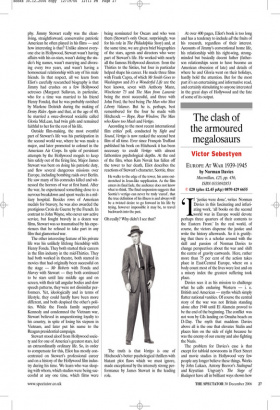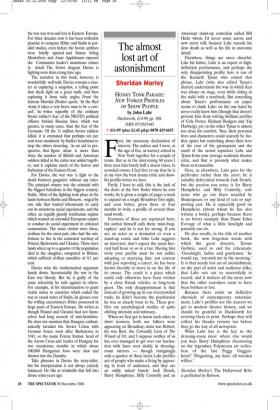The clash of the armoured megalosaurs
Victor Sebestyen
EUROPE AT WAR 1939-1945 by Norman Davies Macmillan, £25, pp. 456, ISBN 0333692853 ✆ £20 (plus £2.45 p&p) 0870 429 6655 ‘If ‘justice were done’, writes Norman Davies in this fascinating and infuriating work, ‘all books on the second world war in Europe would devote perhaps three quarters of their contents to the Eastern Front.’ In the real world, of course, the victors dispense the justice and write the history afterwards. So it is gratifying that there is a scholar around with the skill and passion of Norman Davies to change perspectives about the war and shift the centre of gravity eastwards. Here, rather more than 75 per cent of the action takes place in East/Central Europe, where on a body count most of the lives were lost and on a misery index the greatest suffering took place.
Davies sees it as his mission to challenge what he calls enduring Western — i. e. British and American — myths which simply flatter national vanities. Of course the central story of the war was not Britain standing alone after 1940 until El Alamein proved to be the end of the beginning. The conflict was not won by GIs landing on Omaha beach on D-Day. The myth that maddens Davies above all is the one that elevates Stalin and places him on the side of right because he was the enemy of our enemy and also fighting the Nazis.
The problem for Davies’s case is that except for tabloid newsrooms in Fleet Street and movie studios in Hollywood very few people any longer believe these things. Works by John Lukacs, Antony Beevor’s Stalingrad and Krysztian Ungvary’s The Siege of Budapest have all in brilliant ways shown how the war was won and lost in Eastern Europe. For three decades now it has been orthodox practice to compare Hitler and Stalin in parallel studies, even before the Soviet archives were briefly opened and Simon Sebag Montefiore and Anne Applebaum exposed the Communist leader’s monstrous crimes in detail. The Soviet dragons Davies is fighting were slain a long time ago.
The narrative in this book, however, is wonderfully well told. Davies remains a master at capturing a snapshot, a telling point that sheds light on a great truth, and then exploring it from wide angles. From the famous Marshal Zhukov quote, ‘In the Red Army it takes a very brave man to be a coward’, he writes superbly of the ordinary Soviet soldier’s fear of the NKVD’s political officers behind Russian lines, which was greater, in many cases, than the fear of the Germans. Of the 11 million Soviet soldiers killed, it is estimated that perhaps ten per cent were murdered by Stalin’s henchmen to stop the others deserting. As an aid to perspective, that figure alone is more than twice the number of British and American soldiers killed in the entire war added together, and it explains much of the horror and barbarism of the Eastern Front.
For Davies, the war was ‘a fight to the death between gangsters’ without any rules. The principal winner was the criminal with the biggest battalions in the biggest country, Stalin. Most of the fighting took place in the lands between Berlin and Moscow, waged by one side that wanted lebensraum to carry out its monstrous racial experiments, and the other, an equally ghastly totalitarian regime which wanted an extended European empire to conduct its social experiment in enforced communism. The main victims were those, civilians for the most part, who had the misfortune to live in the contested territory of Poland, Byelorussia and Ukraine. These were lands where up to a quarter of the population died in the slaughter, compared to Britain, which suffered civilian casualties of 0.1 per cent.
Davies wins the mathematical argument hands down. Incontestably the war in the East was bloody. But he is guilty of the same selectivity he rails against in others. For example, in his determination to grant victim status to countries which ended the war as vassal states of Stalin, he glosses over the willing executioners Hitler possessed in large parts of Eastern Europe. He writes as though Poland and Ukraine had not themselves had long records of anti-Semitism. He does not mention that Hungary enthusiastically invaded the Soviet Union with German forces soon after Barbarossa in 1941, or the name Ferenc Szalasi, head of the Arrow Cross and leader of Hungary for two murderous months in which about 100,000 Hungarian Jews were shot and thrown into the Danube.
Take pleasure in Davies the story-teller, but his interpretation is not always entirely balanced. He tilts at windmills that fell into disuse some years ago.





































 Previous page
Previous page